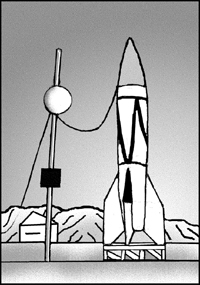|
|
|
|
||||||||||
|
||||||||||||
 |
||||||||||||
|
|
|
 |
|
Speculative Spaceships |
|
Introduction If you're like me, and there is some evidence that suggests that there are a good many of us, you like to look at images of spaceships. A cursory check of the internet indicates there are a lot of them out there. Just to limit the scope somewhat, we can group them by decade, for example, the late 1920's and 1930's, 1940's, 1950's and 1960's. This turns out to be useful because there are distinct differences associated with each decade. Further, based on the time period, we can speculate why the spaceships of each decade look the way they do.
Late 1920's and 1930's The 1930's spaceships are distinguished by colorful, one might say garish, paint schemes and cartoonish appearance. One of the reasons for that is a lot of them were actually in comic strips and graced the covers of pulp science fiction magazines. The images we have included are of more serious designs. The ones from the movies, for example, are beginning to resemble what we would think of as more contemporary designs. Specifically "The Shape of Things" and "Woman in the Moon", particularly the latter, because "Shape..." was a space cannon a la Jules Verse, albeit much larger, and not a rocket at all. The rocket in the "Woman in the Moon" closely resembled the experimental rockets of the time. That is undoubtedly due to the fact that the technical advisor for the film was Herman Oberth, probably the foremost German rocket scientist of the day. Although after having viewed many images, it somewhat resembles a platform shoe with its overly long and clunky fins. One can only speculate what the slots in the fins are for, although some images show exhaust exiting them, suggesting a ramjet, a totally theoretical concept in 1929.
1940's The 1940's was perhaps the "lost decade" for speculative spaceships in that developments in actual rocketry overshadowed the speculative ones. To acknowledge that, we have included the iconic rocket of the time, namely the German V-2. Its design forms the basis of all rocket/spaceship design for that decade and the early part of the next. All the basics are there: the streamlined look with the fins, liquid fuel propulsion and steerable rocket engine controlled by a guidance system. Although secret during World War II, the testing of captured V-2 rockets at White Sands Proving Grounds, New Mexico provided us and science fiction movie directors of the day with ample stock footage to lend authenticity to many of the science fiction B movies of the early 1950's.
1950's Speculative spaceship design in the 1950's was dominated by three giants: Chesley Bonestell, Walt Disney and Werhner Von Braun. Bonestell provided the imagination through his magnificent spaceships and spacescapes. Walt Disney provided the Magic Kingdom and a TV program, "The Wonderful World of Disney", and finally Von Braun provided the legitimacy so that even the most Earthbound-minded people could believe in space travel. Starting with "Destination Moon" and ending with "The Conquest of Space", the Bonestell influence was obvious. 1960's The 1960's began with "The First Spaceship on Venus" and ended with the mind-bending "2001: A Space Odyssey". By the end of the decade, speculative spaceships would never be the same. "2001... " set such a high bar that we had to wait for "Silent Running" before we saw a new spaceship design. Of course, no discussion of 1960's spaceships would be complete without mentioning the "Enterprise" in the TV series "Star Trek", a complete departure from what went before. This journey is complete with the end of the 1960's. We had to wait until the late seventies before the next leap: the transition from clean, white spaceships to the purposely worn-out look of the "Star Wars" universe, a topic for another time perhaps.... |
|
[Index] [About Us] [Stories] [Guest Art] [Guest Art Page] [Editors Write] [Archives] [Contact Us] [Links] |


